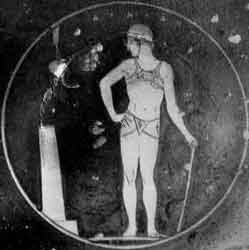.
N - O - P - Q - R - S - T - U - V - W - X - Y - Z
Bikini ?

Euaion painter, Atalante wearing a "bikini", Louvre CA2259
Bricks
Burnt brick first used in Greece in 355 BC, but unreliable (Vitruvius 2.8.19)
There are three sorts of bricks; the first is that which the Greeks call Didoron ( didwron), being the sort we use; that is, one foot long, and half a foot wide. The two other sorts are used in Grecian buildings; one is called Pentadoron, the other Tetradoron. By the word Doron the Greeks mean a palm, because the word dwron signifies a gift which can be borne in the palm of the hand. That sort, therefore, which is five palms each way is called Pentadoron; that of four palms, Tetradoron. The former of these two sorts is used in public buildings, the latter in private. ...The proper seasons for brick-making are the spring and autumn, because they then dry more quably. Those made in the summer solstice are defective, because the heat of the sun soon imparts to their external surfaces an appearance of sufficient dryness, whilst the internal parts of them are in a very different state; hence, when thoroughly dry, they shrink and break those parts which were dry in the first instance; and thus broken, their strength is gone. Those are best that have been made at least two years; for in a period less than that they will not dry thoroughly. When plastering is laid and set hard on bricks which are not perfectly dry, the bricks, which will naturally shrink, and consequently occupy a less space than the plastering, will thus leave the latter to stand of itself. From its being extremely thin, and not capable of supporting itself, it soon breaks into pieces; and in its failure sometimes involves even that of the wall. It is not, therefore, without reason that the inhabitants of Utica allow no bricks to be used in their buildings which are not at least five years old, and also approved by a magistrate. Marcus Vitruvius Pollio, de Architectura See also VITRUVIUS, BOOK II, CHAPTER 3 On bricks
Bucket Chain for lifting water and exploiting water power
Philon of Byzantium (3rd century BC), tells us that the drive shaft was facetted (polygonal, not circular, in cross-section), and that the chain links were shaped to fit the facets. Vitruvius and other Graeco-Roman engineers have provided descriptions of the treadwheels and other devices that were used to power machinery of this type. Museum of London (Working water, Experimental Archaeology)
A - B - C - D - E - F - G - H - I- J - K - L - M -
N - O - P - Q - R - S - T - U - V - W - X - Y - Z
| Ancient Greece
Science, Technology , Medicine , Warfare, , Biographies , Life , Cities/Places/Maps , Arts , Literature , Philosophy ,Olympics, Mythology , History , Images Medieval Greece / Byzantine Empire Science, Technology, Arts, , Warfare , Literature, Biographies, Icons, History Modern Greece Cities, Islands, Regions, Fauna/Flora ,Biographies , History , Warfare, Science/Technology, Literature, Music , Arts , Film/Actors , Sport , Fashion --- |

